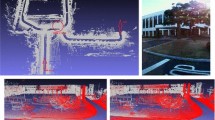Abstract
Tracking the pose of a robot has been gaining importance in the field of Robotics, e.g., paving the way for robot navigation. In recent years, monocular visual–inertial odometry (VIO) is widely used to do the pose estimation due to its good performance and low cost. However, VIO cannot estimate the scale or orientation accurately when robots move along straight lines or circular arcs on the ground. To address the problem, in this paper we take the wheel encoder into account, which can provide us with stable translation information as well as small accumulated errors and momentary slippage errors. By jointly considering the kinematic constraints and the planar moving features, an odometry algorithm tightly coupled with monocular camera, IMU, and wheel encoder is proposed to get robust and accurate pose sensing for mobile robots, which mainly contains three steps. First, we present the wheel encoder preintegration theory and noise propagation formula based on the kinematic mobile robot model, which is the basis of accurate estimation in backend optimization. Second, we adopt a robust initialization method to obtain good initial values of gyroscope bias and visual scale in reality, by making full use of the camera, IMU and wheel encoder measurements. Third, we bound the high computation complexity with a marginalization strategy that conditionally eliminates unnecessary measurements in the sliding window. We implement a prototype and several extensive experiments showing that our system can achieve robust and accurate pose estimation, in terms of the scale, orientation and location, compared with the state-of-the-art.







Similar content being viewed by others
References
Engel, J., Koltun, V., Cremers, D.: Direct sparse odometry. IEEE Trans. Pattern Anal. Mach. Intell. 40(3), 611–625 (2018)
Fischler, M.A., Bolles, R.C.: Random sample consensus: a paradigm for model fitting with applications to image analysis and automated cartography. Commun. ACM 24(6), 381–395 (1981)
Golub, G., Reinsch, C.: Singular value decomposition and least squares solutions. Numerische Mathematik 14, 403–420 (1970)
Grisetti, G., Stachniss, C., Burgard, W.: Improving grid-based SLAM with Rao-Blackwellized particle filters by adaptive proposals and selective resampling. In: Proceedings of IEEE ICRA, pp. 2432–2437 (2005)
Grisetti, G., Stachniss, C., Burgard, W.: Improved techniques for grid mapping with Rao-Blackwellized particle filters. IEEE Trans. Robot. 23(1), 34–46 (2007)
Huber, P.J.: Robust estimation of a location parameter. Ann. Math. Stat. 35(1), 73–101 (1964)
Jianbo, S., Tomasi: Good features to track. In: Proceedings of IEEE CVPR, pp. 593–600 (1994)
Kaiser, J., Martinelli, A., Fontana, F., Scaramuzza, D.: Simultaneous state initialization and gyroscope bias calibration in visual inertial aided navigation. IEEE Robot. Autom. Lett. 2(1), 18–25 (2017)
Lepetit, V., Moreno-Noguer, F., Fua, P.: EPnP: an accurate O(n) solution to the PnP problem. Int. J. Comput. Vis. 81(2), 155–166 (2009)
Leutenegger, S., Chli, M., Siegwart, R.Y.: Brisk: Binary robust invariant scalable keypoints. In: Proceedings of IEEE ICCV, pp. 2548–2555 (2011)
Leutenegger, S., Lynen, S., Bosse, M., Siegwart, R., Furgale, P.: Keyframe-based visual–inertial odometry using nonlinear optimization. Int. J. Robot. Res. 34(3), 314–334 (2014)
Li, D., Eckenhoff, K., Wang, Y., Xiong, R., Huang, G.: Gyro-aided camera-odometer online calibration and localization. In: Proceedings of IEEE ACC, pp. 3579–3586 (2017)
Liu, J., Gao, W., Hu, Z.: Visual–inertial odometry tightly coupled with wheel encoder adopting robust initialization and online extrinsic calibration. In: Proceedings of IEEE/RSJ IROS, pp. 5391–5397 (2019)
Lucas, B.D., Kanade, T.: An iterative image registration technique with an application to stereo vision. In: Proceedings of IJCAI, pp. 674–679 (1997)
Martinelli, A.: Closed-form solution of visual–inertial structure from motion. Int. J. Comput. Vis. 106, 138–152 (2014)
Mikolajczyk, K., Schmid, C.: Scale & affine invariant interest point detectors. Int. J. Comput. Vis. 60(1), 63–86 (2004)
Mourikis, A.I., Roumeliotis, S.I.: A multi-state constraint Kalman filter for vision-aided inertial navigation. In: Proceedings of IEEE ICRA, pp. 3565–3572 (2007)
Mur-Artal, R., Tardós, J.D.: Visual–inertial monocular SLAM with map reuse. IEEE Robot. Autom. Lett. 2(2), 796–803 (2016)
Mur-Artal, R., Montiel, J.M.M., Tardós, J.D.: ORB-SLAM: a versatile and accurate monocular SLAM system. IEEE Trans. Robot. 31(5), 1147–1163 (2015)
Nister, D.: An efficient solution to the five-point relative pose problem. IEEE Trans. Pattern Anal. Mach. Intell. 26(6), 756–770 (2004)
Qin, T., Li, P., Shen, S.: VINS-Mono: a robust and versatile monocular visual–inertial state estimator. IEEE Trans. Robot. 34(4), 1004–1020 (2018)
Qin, T., Pan, J., Cao, S., Shen, S.: A general optimization-based framework for local odometry estimation with multiple sensors (2019). arXiv:1901.03638
Shen, S., Mulgaonkar, Y., Michael, N., Kumar, V.: Initialization-Free Monocular Visual–Inertial State Estimation with Application to Autonomous MAVs, pp. 211–227 (2016)
Sibley, G., Matthies, L., Sukhatme, G.: Sliding window filter with application to planetary landing. J. Field Robot. 27(5), 587–608 (2010)
Sturm, J., Engelhard, N., Endres, F., Burgard, W., Cremers, D.: A benchmark for the evaluation of RGB-D SLAM systems. In: Proceedings of IEEE/RSJ IROS, pp. 573–580 (2012)
Triggs, B., McLauchlan, P.F., Hartley, R.I., Fitzgibbon, A.W.: Bundle adjustment—a modern synthesis. In: Proceedings of IWVA, pp. 298–372 (2000)
Wu, C.: Towards linear-time incremental structure from motion. In: Proceedings of IEEE 3DV, pp. 127–134 (2013)
Wu, K.J., Chao, G.X., Georgiou, G., Roumeliotis, S.I.: Vins on wheels. In: Proceedings of IEEE ICRA, pp. 5155–5162 (2017)
Yang, Z., Shen, S.: Monocular visual–inertial state estimation with online initialization and camera–IMU extrinsic calibration. IEEE Trans. Autom. Sci. Eng. 14(1), 39–51 (2017)
Yang, D., Bi, S., Wang, W., Yuan, C., Qi, X., Cai, Y.: DRE-SLAM: dynamic RGB-D encoder SLAM for a differential-drive robot. Remote Sens. 11(4), 380 (2019)
Acknowledgements
This work is supported by the National Natural Science Foundation of China (nos. 61702257 and 61771236), Natural Science Foundation of Jiangsu Province (no. BK20170648), Fundamental Research Funds for the Central Universities (14380066), and Collaborative Innovation Center of Novel Software Technology and Industrialization. Jia Liu and Lijun Chen are the corresponding authors.
Author information
Authors and Affiliations
Corresponding authors
Rights and permissions
About this article
Cite this article
Niu, Y., Liu, J., Wang, X. et al. Accurate and robust odometry by fusing monocular visual, inertial, and wheel encoder. CCF Trans. Pervasive Comp. Interact. 2, 275–287 (2020). https://doi.org/10.1007/s42486-020-00040-4
Received:
Accepted:
Published:
Issue Date:
DOI: https://doi.org/10.1007/s42486-020-00040-4




